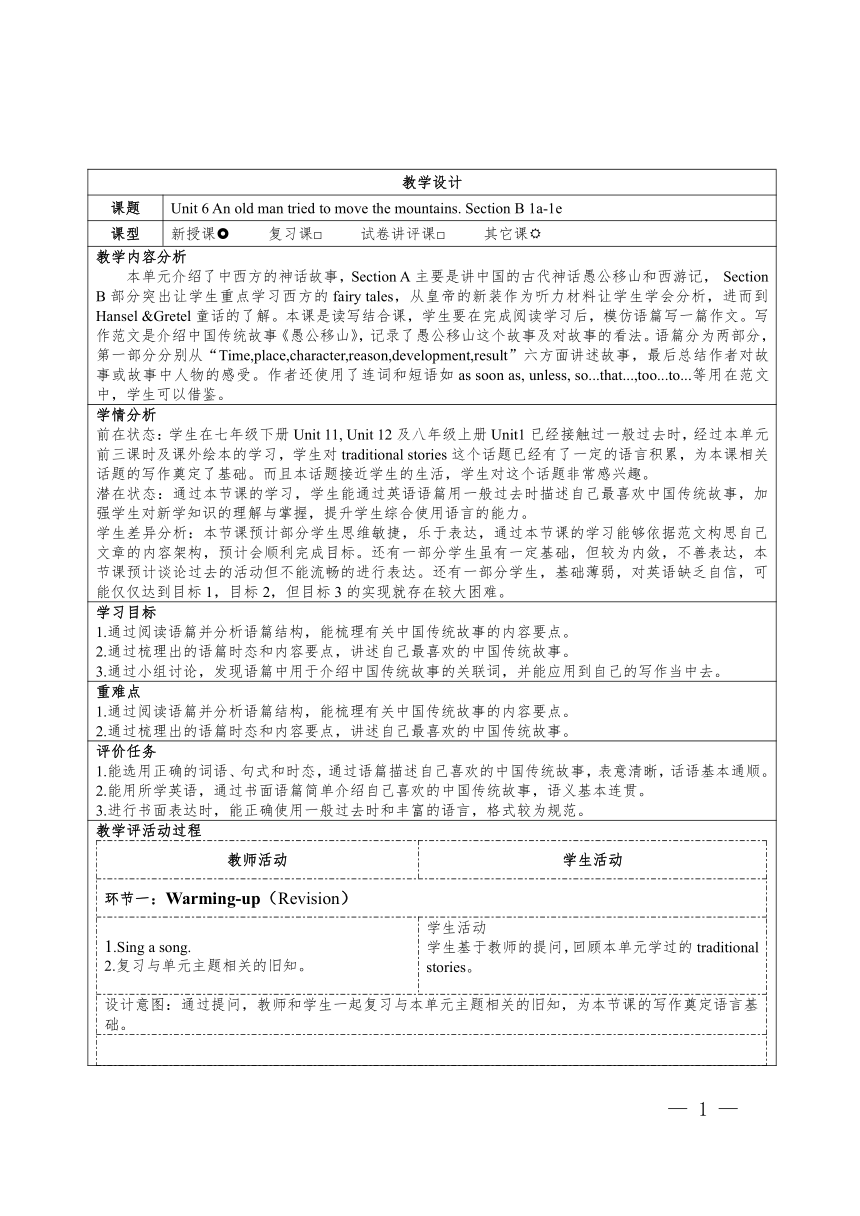Unit 6 An old man tried to move the mountains.Section B 1a-1e教学设计2024-2025学年人教新目标(Go for it)版英语八年级下册
文档属性
| 名称 | Unit 6 An old man tried to move the mountains.Section B 1a-1e教学设计2024-2025学年人教新目标(Go for it)版英语八年级下册 |  | |
| 格式 | docx | ||
| 文件大小 | 23.8KB | ||
| 资源类型 | 教案 | ||
| 版本资源 | 人教新目标(Go for it)版 | ||
| 科目 | 英语 | ||
| 更新时间 | 2024-12-10 22:56:05 | ||
图片预览


文档简介
教学设计
课题 Unit 6 An old man tried to move the mountains. Section B 1a-1e
课型 新授课 复习课□ 试卷讲评课□ 其它课
教学内容分析 本单元介绍了中西方的神话故事,Section A主要是讲中国的古代神话愚公移山和西游记, Section B部分突出让学生重点学习西方的fairy tales,从皇帝的新装作为听力材料让学生学会分析,进而到Hansel &Gretel童话的了解。本课是读写结合课,学生要在完成阅读学习后,模仿语篇写一篇作文。写作范文是介绍中国传统故事《愚公移山》,记录了愚公移山这个故事及对故事的看法。语篇分为两部分,第一部分分别从“Time,place,character,reason,development,result”六方面讲述故事,最后总结作者对故事或故事中人物的感受。作者还使用了连词和短语如as soon as, unless, so...that...,too...to...等用在范文中,学生可以借鉴。
学情分析 前在状态:学生在七年级下册Unit 11, Unit 12及八年级上册Unit1已经接触过一般过去时,经过本单元前三课时及课外绘本的学习,学生对traditional stories这个话题已经有了一定的语言积累,为本课相关话题的写作奠定了基础。而且本话题接近学生的生活,学生对这个话题非常感兴趣。 潜在状态:通过本节课的学习,学生能通过英语语篇用一般过去时描述自己最喜欢中国传统故事,加强学生对新学知识的理解与掌握,提升学生综合使用语言的能力。 学生差异分析:本节课预计部分学生思维敏捷,乐于表达,通过本节课的学习能够依据范文构思自己文章的内容架构,预计会顺利完成目标。还有一部分学生虽有一定基础,但较为内敛,不善表达,本节课预计谈论过去的活动但不能流畅的进行表达。还有一部分学生,基础薄弱,对英语缺乏自信,可能仅仅达到目标1,目标2,但目标3的实现就存在较大困难。
学习目标 1.通过阅读语篇并分析语篇结构,能梳理有关中国传统故事的内容要点。 2.通过梳理出的语篇时态和内容要点,讲述自己最喜欢的中国传统故事。 3.通过小组讨论,发现语篇中用于介绍中国传统故事的关联词,并能应用到自己的写作当中去。
重难点 1.通过阅读语篇并分析语篇结构,能梳理有关中国传统故事的内容要点。 2.通过梳理出的语篇时态和内容要点,讲述自己最喜欢的中国传统故事。
评价任务 1.能选用正确的词语、句式和时态,通过语篇描述自己喜欢的中国传统故事,表意清晰,话语基本通顺。 2.能用所学英语,通过书面语篇简单介绍自己喜欢的中国传统故事,语义基本连贯。 3.进行书面表达时,能正确使用一般过去时和丰富的语言,格式较为规范。
教学评活动过程 教师活动学生活动环节一:Warming-up(Revision)1.Sing a song. 2.复习与单元主题相关的旧知。学生活动 学生基于教师的提问,回顾本单元学过的traditional stories。 设计意图:通过提问,教师和学生一起复习与本单元主题相关的旧知,为本节课的写作奠定语言基础。环节二:梳理时态教师活动 Step 1 T shows the writing materials. Step 2: Read the passage and answer the questions. What tense does the writer use in the passage 学生活动 1.Ss read the writing material. 2.Ss read the passage and find out the tense of the passage.设计意图展示作文题目,让学生明确写作主题和要点;通过阅读语篇,让学生初步感知写故事时需用的时态。环节三:梳理内容要点教师活动 Step1.Read the passage and answer the following questions. 1. Who is the main character? 2. When did the story happen 3. Where did the story happen 4. How did the story begin 5. What happened next 6. What’s the ending of the story Step 2 Sum up how the writer describes the story 学生活动 1.Ss read the passage and answer the questions. 2.Ss sum up the main contents of the story. 设计意图通过回答问题,进一步分析语篇的内容要点,让学生进一步明晰写故事从哪些方面进行书写,为笔头输出做准备。环节四:梳理语言教师活动 Step 1 Let the ss use the rich expressions to enrich the article and touch the readers. Step 2 Ask ss “What do you think of the story of Yu Gong ” Step 3 Let ss read new the article with better expressions.学生活动 1.Ss read the passage again and then use the rich expressions to enrich the article l(as soon as...., unless, too...to..., so...that...).And share them in groups. 2.Discuss it in groups and then share their ideas. 3.Ss read the new article with better expressions.. 设计意图通过最后一遍阅读,引导学生学习和分析与本主题相关的有效语言表达,并能应用到自己的作文中去。环节五:迁移创新教师活动 Step 1T shows and introduces the standard of the story to Ss and then let ss share their own favorite Chinese traditional stories. Step 2 Writing time.学生活动 1.Ss learn the standards and then share their own favorite Chinese traditional stories.. 2.Ss write the passage by themselves.设计意图在写作之前,引导学生写一个好故事的评价标准,让学生明白一个好故事应该包括哪些方面,也便于学生写完作文后参照标准进行自评和修改。
作业与拓展学习设计 You must:Write down your article and polish your handwriting. If you can:Read more stories and share the stories with your classmates.
— 4 —
— 3 —
课题 Unit 6 An old man tried to move the mountains. Section B 1a-1e
课型 新授课 复习课□ 试卷讲评课□ 其它课
教学内容分析 本单元介绍了中西方的神话故事,Section A主要是讲中国的古代神话愚公移山和西游记, Section B部分突出让学生重点学习西方的fairy tales,从皇帝的新装作为听力材料让学生学会分析,进而到Hansel &Gretel童话的了解。本课是读写结合课,学生要在完成阅读学习后,模仿语篇写一篇作文。写作范文是介绍中国传统故事《愚公移山》,记录了愚公移山这个故事及对故事的看法。语篇分为两部分,第一部分分别从“Time,place,character,reason,development,result”六方面讲述故事,最后总结作者对故事或故事中人物的感受。作者还使用了连词和短语如as soon as, unless, so...that...,too...to...等用在范文中,学生可以借鉴。
学情分析 前在状态:学生在七年级下册Unit 11, Unit 12及八年级上册Unit1已经接触过一般过去时,经过本单元前三课时及课外绘本的学习,学生对traditional stories这个话题已经有了一定的语言积累,为本课相关话题的写作奠定了基础。而且本话题接近学生的生活,学生对这个话题非常感兴趣。 潜在状态:通过本节课的学习,学生能通过英语语篇用一般过去时描述自己最喜欢中国传统故事,加强学生对新学知识的理解与掌握,提升学生综合使用语言的能力。 学生差异分析:本节课预计部分学生思维敏捷,乐于表达,通过本节课的学习能够依据范文构思自己文章的内容架构,预计会顺利完成目标。还有一部分学生虽有一定基础,但较为内敛,不善表达,本节课预计谈论过去的活动但不能流畅的进行表达。还有一部分学生,基础薄弱,对英语缺乏自信,可能仅仅达到目标1,目标2,但目标3的实现就存在较大困难。
学习目标 1.通过阅读语篇并分析语篇结构,能梳理有关中国传统故事的内容要点。 2.通过梳理出的语篇时态和内容要点,讲述自己最喜欢的中国传统故事。 3.通过小组讨论,发现语篇中用于介绍中国传统故事的关联词,并能应用到自己的写作当中去。
重难点 1.通过阅读语篇并分析语篇结构,能梳理有关中国传统故事的内容要点。 2.通过梳理出的语篇时态和内容要点,讲述自己最喜欢的中国传统故事。
评价任务 1.能选用正确的词语、句式和时态,通过语篇描述自己喜欢的中国传统故事,表意清晰,话语基本通顺。 2.能用所学英语,通过书面语篇简单介绍自己喜欢的中国传统故事,语义基本连贯。 3.进行书面表达时,能正确使用一般过去时和丰富的语言,格式较为规范。
教学评活动过程 教师活动学生活动环节一:Warming-up(Revision)1.Sing a song. 2.复习与单元主题相关的旧知。学生活动 学生基于教师的提问,回顾本单元学过的traditional stories。 设计意图:通过提问,教师和学生一起复习与本单元主题相关的旧知,为本节课的写作奠定语言基础。环节二:梳理时态教师活动 Step 1 T shows the writing materials. Step 2: Read the passage and answer the questions. What tense does the writer use in the passage 学生活动 1.Ss read the writing material. 2.Ss read the passage and find out the tense of the passage.设计意图展示作文题目,让学生明确写作主题和要点;通过阅读语篇,让学生初步感知写故事时需用的时态。环节三:梳理内容要点教师活动 Step1.Read the passage and answer the following questions. 1. Who is the main character? 2. When did the story happen 3. Where did the story happen 4. How did the story begin 5. What happened next 6. What’s the ending of the story Step 2 Sum up how the writer describes the story 学生活动 1.Ss read the passage and answer the questions. 2.Ss sum up the main contents of the story. 设计意图通过回答问题,进一步分析语篇的内容要点,让学生进一步明晰写故事从哪些方面进行书写,为笔头输出做准备。环节四:梳理语言教师活动 Step 1 Let the ss use the rich expressions to enrich the article and touch the readers. Step 2 Ask ss “What do you think of the story of Yu Gong ” Step 3 Let ss read new the article with better expressions.学生活动 1.Ss read the passage again and then use the rich expressions to enrich the article l(as soon as...., unless, too...to..., so...that...).And share them in groups. 2.Discuss it in groups and then share their ideas. 3.Ss read the new article with better expressions.. 设计意图通过最后一遍阅读,引导学生学习和分析与本主题相关的有效语言表达,并能应用到自己的作文中去。环节五:迁移创新教师活动 Step 1T shows and introduces the standard of the story to Ss and then let ss share their own favorite Chinese traditional stories. Step 2 Writing time.学生活动 1.Ss learn the standards and then share their own favorite Chinese traditional stories.. 2.Ss write the passage by themselves.设计意图在写作之前,引导学生写一个好故事的评价标准,让学生明白一个好故事应该包括哪些方面,也便于学生写完作文后参照标准进行自评和修改。
作业与拓展学习设计 You must:Write down your article and polish your handwriting. If you can:Read more stories and share the stories with your classmates.
— 4 —
— 3 —
同课章节目录
- Unit 1 What's the matter?
- Section A
- Section B
- Unit 2 I'll help to clean up the city parks.
- Section A
- Section B
- Unit 3 Could you please clean your room?
- Section A
- Section B
- Unit 4 Why don't you talk to your parents?
- Section A
- Section B
- Unit 5 What were you doing when the rainstorm came
- Section A
- Section B
- Review of Units 1-5
- Unit 6 An old man tried to move the mountains.
- Section A
- Section B
- Unit 7 What's the highest mountain in the world?
- Section A
- Section B
- Unit 8 Have you read Treasure Island yet?
- Section A
- Section B
- Unit 9 Have you ever been to a museum?
- Section A
- Section B
- Unit 10 I've had this bike for three years.
- Section A
- Section B
